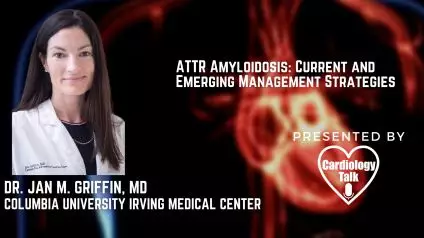Jan M. Griffin, MD- ATTR Amyloidosis: Current and Emerging Management Strategies: JACC: CardioOncology State-of-the-A...
Dr. Jan Griffin is a cardiologist at New York-Presbyterian/Columbia University Irving Medical Center in New York, NY. She graduated from the Royal College of Surgeons of Ireland with a medical degree. In this video Dr. Griffin discusses ATTR Amyloidosis: Current and Emerging Management Strategies.
Link to Abstract-
https://www.jacc.org/doi/10.1016/j.jaccao.2021.05.004
Abstract-
Because of noninvasive imaging and increased awareness, transthyretin cardiac amyloidosis (ATTR-CA) is becoming more common. Because pathogenic alleles do not have complete clinical penetrance, there is a substantial population of asymptomatic transthyretin variant carriers. More research is needed into screening techniques, monitoring, and therapy of subclinical ATTR-CA. The development of effective medicines based on a scientific understanding of ATTR-CA pathogenesis is perhaps the most significant translational success. These include recently established transthyretin protein stabilization and transthyretin production suppression methods. Data on neurohormonal blocking in ATTR-CA is scarce, with medical treatment focusing primarily on fluid management. Atrial fibrillation is a frequent condition that necessitates anticoagulation due to the risk of thrombus formation. Although conduction disorders and ventricular arrhythmias are common, little is known about the best ways to treat them. Finally, because aortic stenosis and ATTR-CA are usually seen together, transcatheter valve replacement is the chosen treatment option.
Highlights
• ATTR-CA is becoming more well-known as a result of increased awareness and the development of noninvasive diagnostic approaches.
• Clinical penetrance of harmful alleles is incomplete, with inadequate data for asymptomatic carriers' screening or care.
• Biological understanding of ATTR-CA pathophysiology has led to effective TTR stabilizers and silencers as targeted therapeutics.
• Future treatments could involve CRISPR, amyloid extraction/degradation, and amyloid seeding inhibition.
Introduction
Over the last decade, the field of transthyretin cardiac amyloidosis (ATTR-CA) has undergone a transformation, with an increasing recognition that many ATTR-CA patients were previously undiagnosed and instead assumed to have hypertension, heart failure with preserved ejection fraction (HFpEF), or hypertrophic cardiomyopathy (1). Delays in diagnosis were almost prevalent, and they still exist today, sadly (2). However, with increased awareness of clinical clues and the ability to diagnose ATTR-CA without a biopsy (3), reports have shown ATTR-CA in patients hospitalized with HFpEF (13%) (4), patients with severe aortic stenosis undergoing transcatheter aortic valve replacement (TAVR) (16%) (5), and up to 40% of high-risk populations, such as Afro-Caribbeans with heart failure and increased ventricular wall thickness undergoing TAVR (6). As a result, every cardiologist has come across patients with ATTR-CA, whether they are aware of it or not. Despite the exponential increase in the use of cardiac bone scintigraphy and multisocietal guidelines supporting nonbiopsy diagnosis (7,8), there are certain major traps to avoid. Failure to check for monoclonal proteins or an over-reliance on planar imaging are two examples (9). The development of effective medicines based on a biological understanding of the underlying pathophysiology has been the most significant "translational victory" (10). These treatments have a significant impact on the quality and quantity of life for those who are afflicted. This article focuses on the treatment of ATTR-CA patients and the evolving therapy landscape (Central Illustration).




